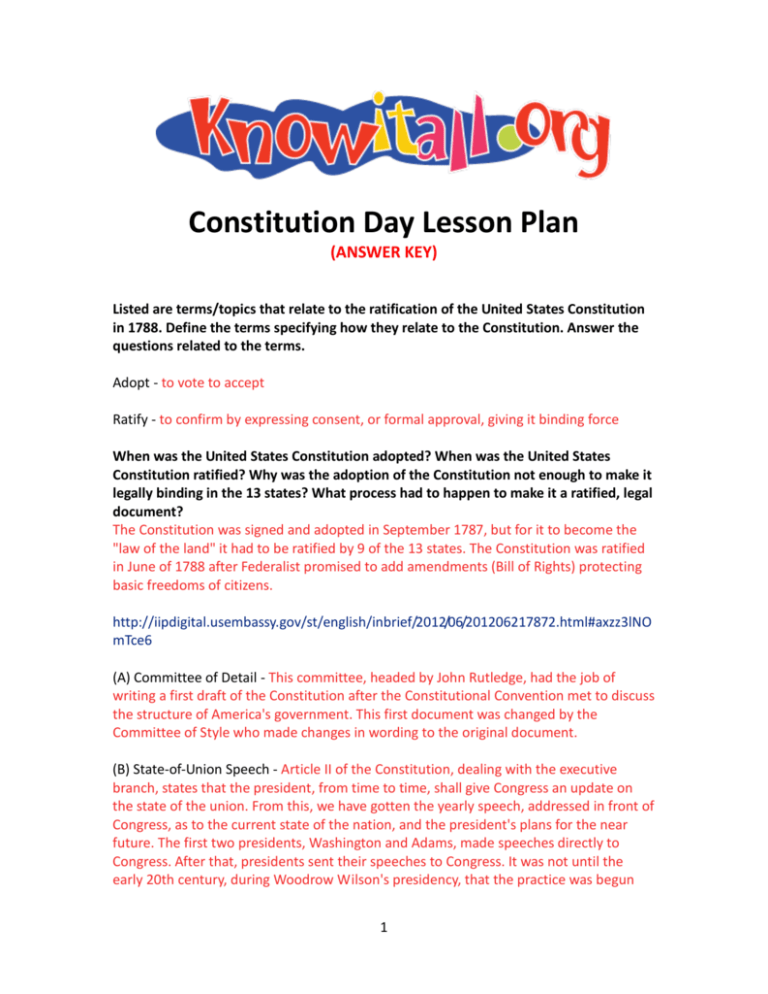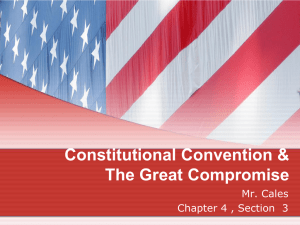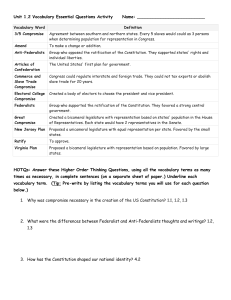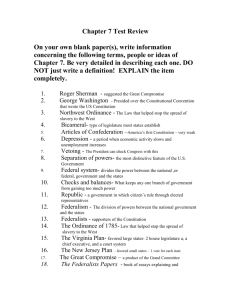Constitution Day Lesson Plan
advertisement

Constitution Day Lesson Plan (ANSWER KEY) Listed are terms/topics that relate to the ratification of the United States Constitution in 1788. Define the terms specifying how they relate to the Constitution. Answer the questions related to the terms. Adopt - to vote to accept Ratify - to confirm by expressing consent, or formal approval, giving it binding force When was the United States Constitution adopted? When was the United States Constitution ratified? Why was the adoption of the Constitution not enough to make it legally binding in the 13 states? What process had to happen to make it a ratified, legal document? The Constitution was signed and adopted in September 1787, but for it to become the "law of the land" it had to be ratified by 9 of the 13 states. The Constitution was ratified in June of 1788 after Federalist promised to add amendments (Bill of Rights) protecting basic freedoms of citizens. http://iipdigital.usembassy.gov/st/english/inbrief/2012/06/201206217872.html#axzz3lNO mTce6 (A) Committee of Detail - This committee, headed by John Rutledge, had the job of writing a first draft of the Constitution after the Constitutional Convention met to discuss the structure of America's government. This first document was changed by the Committee of Style who made changes in wording to the original document. (B) State-of-Union Speech - Article II of the Constitution, dealing with the executive branch, states that the president, from time to time, shall give Congress an update on the state of the union. From this, we have gotten the yearly speech, addressed in front of Congress, as to the current state of the nation, and the president's plans for the near future. The first two presidents, Washington and Adams, made speeches directly to Congress. After that, presidents sent their speeches to Congress. It was not until the early 20th century, during Woodrow Wilson's presidency, that the practice was begun 1 again. (C) Atlantic Slave trade - International trade where Africans were forcibly captured and brought to the Western Hemisphere for labor. Beginning in 1626, more than 300,000 Africans were brought to the United States via the Atlantic Slave trade. http://www.slavevoyages.org/tast/assessment/estimates.faces At what point did this practice end in the United States? How did the ending of the slave trade tie directly to the Constitution? Many southern delegates to the Constitutional Convention were in favor of continuing the Atlantic slave trade, initially begun during colonial rule, because slave labor and the selling of slaves was foundational to the southern economy. Two committees, both on which Charles Cotesworth Pinckney served, came up with compromises that dealt with trade issues and the different ways the north and south used trade. As a compromise on the overseas slave trade, delegates agreed to discontinue the trade within 20 years. By 1808, the overseas slave trade was illegal in the Unites States, although slave sales within states continued. What other compromise dealt specifically with the issue of slavery? The Three-Fifths Compromise Many people, who were vocally against slavery, felt this compromise legally removed the humanity from slaves and strengthened the cause of slavery for southerners. Give two specific ways this compromise, which was included in, and protected by the Constitution, made slaves, in a legal sense, appear less "human". Because slaves were not counted as a "whole person" in the census count, only three-fifths of a person, the value of slaves as people was lessened. To add to this perception, Southern states were required to pay property taxes on their slaves, which reinforced the idea that slaves were property, not individuals. (D) Fugitive Slave Clause - Pierce Butler was instrumental in getting this clause passed. It required the return of runaway slaves to their owners, even those who made it to free territories or states where slavery was illegal. What's a clause and why was this one so important? A clause is a phrase or sentence in a legal document. This clause protected slavery and reinforced the concept that slaves were property. (E) Commander-in-Chief - The supreme commander of the armed forces of a nation. Article II of the Constitution names the President as the Commander-in-Chief of America's armed forces. (F) Commerce Compromise - This compromise was the result of the work of two 2 committees, both of which were served on by Charles Cotesworth Pinckney, who developed compromises on trades issues that differed between the North and South. This compromise gave Congress the power to pass trade laws, but Congress agreed to not tax Southern exports. At the time the Constitution was ratified, what were the primary Southern exports? How did the southern economy differ from the economy of the north? The primary Southern exports were rice, tobacco, and eventually cotton. The South's economy was based on agriculture and the slave labor that made that economy profitable. This compromise was important to the South, because at the time of the Constitution's ratification, most of the South's agricultural products were exported to European countries, who were the first to industrialize. Although the North became more industrialized and created a more diverse economy, the South remained agriculture and came to relied on the North and Europe for their finished products. (G) Religious freedom - The right to follow one's religious beliefs without fear of interference from the government. The right is guaranteed in Amendment 1 of the Bill of Rights. South Carolina played an important role in the drafting and adoption of our current United States Constitution. The South Carolinians named were part of the Constitutional Convention and contributed to the document ratified in 1788. 1) Identify a "Lettered Term" with one of the South Carolinians present at the Constitutional Convention. John Rutledge - A Charles Pinckney - B, E, G Charles Cotesworth Pinckney - C, F Pierce Butler - D Look at the digital images. Placing the images in an application of your choice, match the image to lettered term, and describe how that image relates to the term and the Constitution. It may be necessary to identify the image in order to relate its significance. Finally, match a South Carolinian to an image, describing how that image relates to the chosen South Carolinians role at the Constitutional Convention. Some individuals or terms may have more than one image associated with them. 3 4








